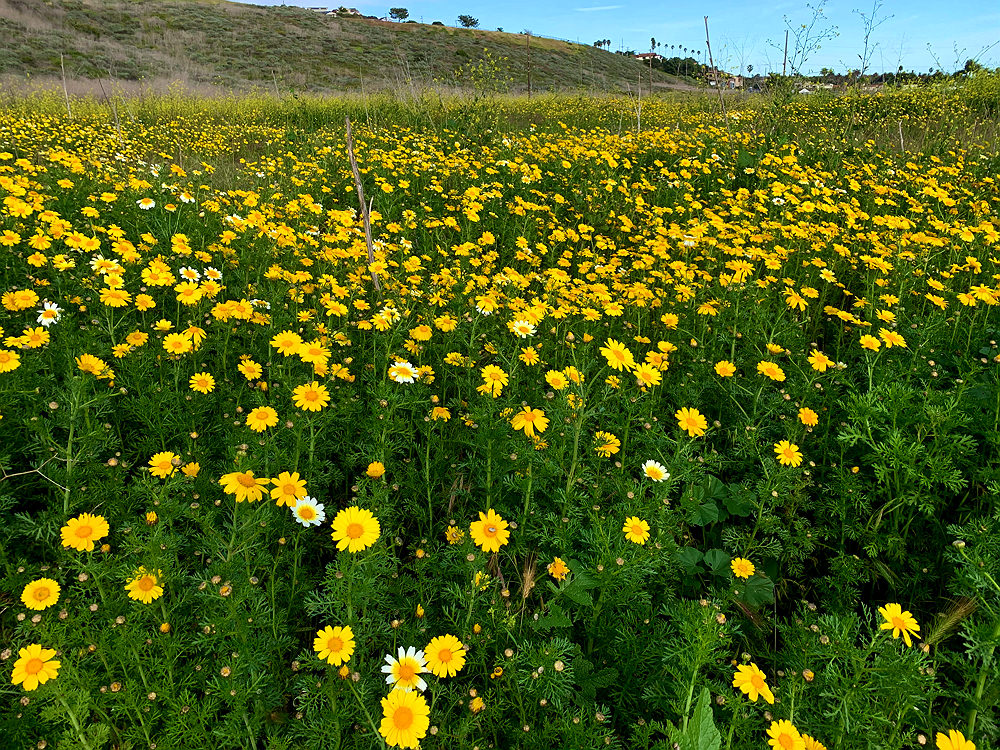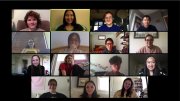I love the way that patches of wild yellow-rayed goldfields slightly reflect the sunlight of the California coast. The stalks of these wildflowers can reach as high as my waist, and their deep green leaves shoot out from the entire length in fractals. Atop the stalk is a yellow daisy-like flower. The sturdy pistil center holds onto the surrounding delicate petals, which might otherwise flutter away into the Pacific.
It’s been a long while since I’ve been home in Southern California to see flowers bloom in the spring—seven years, in fact, ever since I started boarding school as a high-school sophomore. A few days before my first college Zoom class last month, I went on a light hike with my sister along a coastal trail about half an hour from our home. This was before most trails and parks in Los Angeles were shuttered to prevent the spread of COVID-19. Despite the beautiful scenery, the wound of the sudden evacuation from Harvard was still fresh; I was still lamenting that I was no longer on campus to see the bright yellow daffodils bloom by the Charles River. My ideal spring season had been disrupted.

Photograph by Julie Chung
While walking, I suddenly heard the ringing pitch of a cluster of birds bickering in a small shrub. Peering ahead, I saw it: a red-winged blackbird, flashing flecks of scarlet feathers in my direction before flying off to a quieter part of the trail. I couldn’t wait to share the sighting with my Zoom class.
In my class “Women, Men, and Other Animals,” which examines the ways in which human collectives have conceived of other animals, Mel Y. Chen, visiting professor of gender and sexuality studies, encouraged us to interact with the bird species in our home communities and report back after spring break. On what we realized would be the last in-person day of our seminar, Professor Chen took us all outside our Boylston Hall classroom for a bird-watching trip. We trekked along the familiar paths around the Law School and Divinity School in search of sparrows and robins. We aimed to practice what it might mean to be in community with animals and to perceive their own forms of communication and life rhythms. Because there is a sense of what “ideal communication” should look like in our human world, there is often the follow-up assumption that we are barred from fully understanding—and meaningfully engaging with—other animals without a common spoken language. Could we learn instead to communicate with animals through expanding our own ideas about communication, interaction, and senses? Some of us listened to the ways the sparrows chirped and warbled different tunes in response to incoming dogs or cyclists along the path. Others watched intently, sketching out the features of their favorite sparrow perched in the shrubs. Some silently sat cross-legged on the sidewalk, taking in the sudden news that we might never see each other in person again.
There’s a sense that virtual classes have disrupted the “ideal” classroom. Online communication, some say, is just an incomplete imitation or false substitute for the in-person experience. A couple weeks ago, I handed in my senior thesis as an electronic PDF file over email. No fanfare or pictures in front of Widener Library—just a click of a button at 9 a.m. in the morning. Other academic traditions, like my thesis oral defense and research presentations, must all take place over Zoom panel calls. “Admittedly this isn’t as much fun without the catered meal…but these are weird times,” one administrator emailed me when detailing next steps for Zoom thesis presentations.
Luckily, I don’t have any meetings left for my senior thesis tutorial, but I’m still juggling my three remaining lecture and seminar courses. I now watch all of my physics lectures online via pre-recorded videos from the previous year. The workload remains the same, since our problem sets, exams, and labs must all be completed remotely. Of course, the transition to virtual learning hasn’t been a clean, one-to-one translation. Take my virtual physics midterm, for example. To accommodate all time zones and our varied home circumstances, our normally two-hour exam was spread over the course of three days this past week. It’s hard not to become existential when you’re sitting at your kitchen table on a Thursday evening and racking your brain to solve the direction of a magnetic field for an exam that will not even be letter-graded.
While virtual classes have periodically instilled these bouts of existentialism, they’ve also given me a reason to get up in the morning, change out of my pajamas, and engage in interesting discussions with my friends and professors. In our first Zoom class for “Women, Men, and Other Animals,” the students went around the “room”—or more aptly, across the screen display—to share our various bird sightings and reports from home. We were scattered across the country, calling in from Utah, Florida, Michigan, California, Massachusetts, and New York. We got to hear about the lost bird that found its way to the hallway of Jude’s MIT dorm and the titmouse family that had nested outside Professor Chen’s own home in the Bay Area. One student even left our video call when one of her friends suddenly sighted a large predatory bird.
Occurrences like that might be called “disruptions,” and they’re quite common in virtual classes that require the impossible task of cutting off our at-home realities to plug into the classroom. I’d like to think that they’re not always disruptions, but often instead show a different side of my friends and fellow students that I normally don’t get to see. That first Zoom class, I couldn’t stop giggling when Lauren interjected during our discussion that her grandmother was shredding endless reams of paper in the background. It was a glimpse into her home life and family—an intimate facet we’re often encouraged to leave behind when we assume our role as students in the classroom.
I do think that this process has been difficult, and there were many forms of interaction and connection in our Boylston Hall classroom that I miss. But strangely, I also feel closer to some people in my seminar, especially as we’ve been encouraged to talk more about our personal lives and home habitats during our course discussions. I get to see classmates in their pajama shirts and hear the chatter of their family members. I get to meet furry companions that I’d only seen on phone wallpapers or Instagram posts during breaks. And classmates get to meet my own cuddly Maltese, who will bark incessantly until I place her on my lap for everyone to see.
The “ideal” classroom never existed anyway, at least not in a perfectly equitable manner. Our course draws heavily from critical disability studies, which has taught us to challenge the notion of “ideal” forms of communication, interaction, and sensation. As Professor Chen has reminded us, for people with certain disabilities such as immune sensitivities to common chemicals, the close quarters of the typical seminar classroom can be a nightmare. And that’s apart from issues of accessibility related to socioeconomic background, gender, and other factors that shape the ways in which we interact and perform in a classroom.
Of course, Zoom classes are not perfectly accessible either. Harvard students have dispersed throughout the world to radically unequal home situations. Zoom schooling requires the privilege of a stable Internet connection, not to mention a quiet, safe home environment and spare time amid family responsibilities and financial concerns. Before COVID-19, I was a straight-A student who meticulously planned my Google Calendar with color-coded blocks of homework, studying, courses, work, and meetings. Now I don’t have a room of my own or a desk to study on. I’ll feel lucky if I can graduate the semester with all “satisfactory” grades in the College’s new emergency “SAT/UNSAT” grading system.
Letting go of the image of an “ideal” classroom, however—not to mention, an “ideal” spring season, jogging by the daffodils along the Charles—I can appreciate the rest of senior year for what it is. I’m excited every time I see a ruby-throated hummingbird or red-tailed hawk in my neighborhood to share with my classmates who are thousands of miles away. I’m also starting to let go of the instinct to compare or judge my Zoom semester against college life before the evacuation. Everything is different, and different might not always be bad, even when the circumstances that demand the change have been harrowing. Sometimes, different is just that—different—and might require an appropriately new set of orientations, modes of communication, and engagement with our senses to interact with the changing world.








